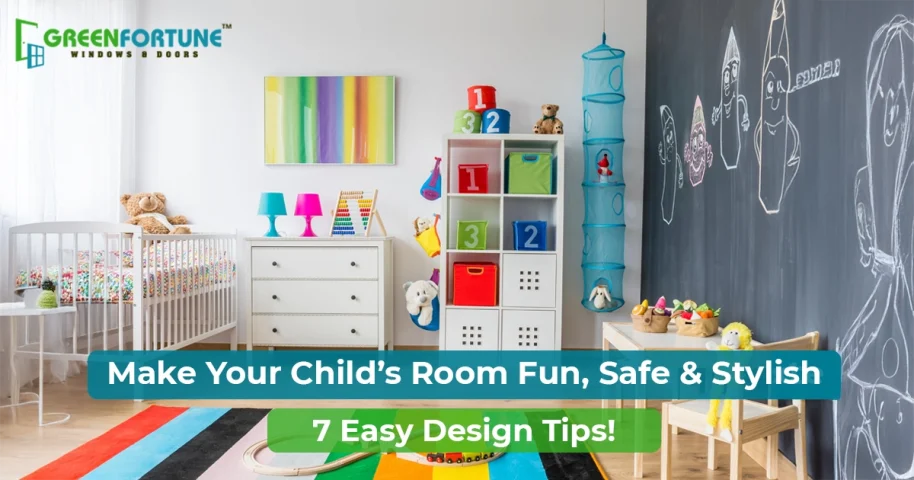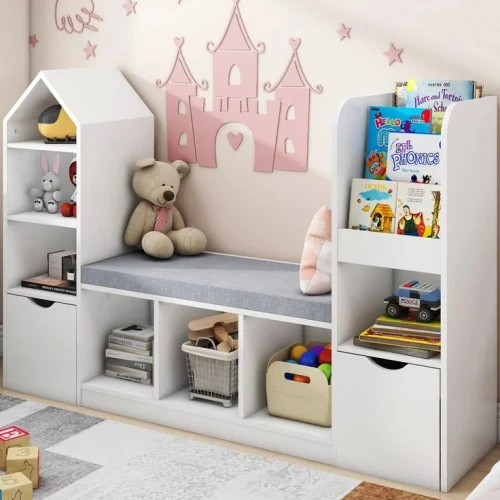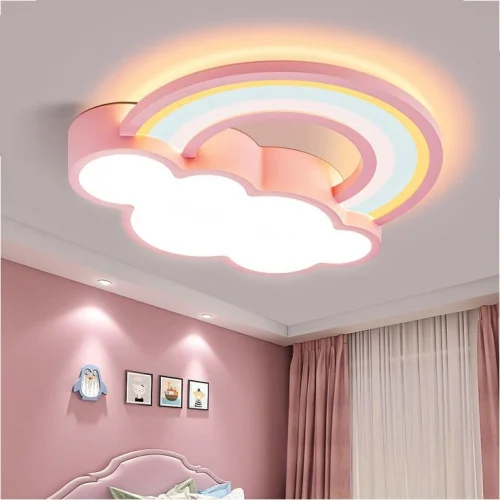
Understanding Slump Test Values: What They Reveal About Concrete Workability
May 21, 2025
Top 6 Stylish & Popular Aluminium Bathroom Gate Designs of 2025
May 22, 2025Designing your child's bedroom is more than just picking out cute furniture—it's about creating a nurturing space where they can dream, grow, and feel completely at home. The right interior design ensures that the space isn't just visually appealing but also practical, safe, and adaptable to their evolving needs.
Let’s dive into the ultimate guide to help you design a magical and functional haven for your child.
Table of contents
- Start with a Thoughtful Theme or Colour Scheme
- Prioritise Functionality and Safety
- Incorporate Plenty of Storage
- Add Personal Touches
- Incorporate Growth-Friendly Elements
- Use Light Creatively
- Additional Tips for Outstanding Interior Design
- Final Thoughts
- Boost Your Child’s Room with Green Fortune’s Eco-Friendly Touch!
- FAQs
Start with a Thoughtful Theme or Colour Scheme
Choosing a theme or colour palette sets the tone for the entire room. While traditional themes like “princess castle” or “outer space” remain popular, modern parents often opt for more versatile designs. Think Scandinavian minimalism, boho chic, or jungle adventures — styles that can evolve with your child’s interests.
Did you know? According to a 2024 American Academy of Paediatrics study, colours can significantly impact mood and behaviour. Soft blues and greens promote calmness, while bright yellows encourage creativity.
Color Scheme | Mood Impact | Best For |
Soft Blue | Calmness, Focus | Study areas, bedrooms |
Pastel Green | Relaxation, Growth | Play corners, reading nooks |
Vibrant Yellow | Energy, Optimism | Creative zones, playrooms |
When choosing the theme, ensure it aligns with the overall interior design for the goals you have in mind. Avoid trends that may fade quickly, and instead, lean into flexible designs that can be easily updated.
Prioritise Functionality and Safety
In any good interior design for a children's room, functionality and safety are the two non-negotiables. Kids need a room that's durable enough to withstand endless play sessions and safe enough for peace of mind.
Practical tips:
- Install rounded furniture to minimise injury risks.
- Choose non-toxic paints and hypoallergenic fabrics.
- Use cordless window treatments to avoid strangulation hazards.
Example: Instead of a sharp-edged wooden study table, opt for a rounded, adjustable plastic or engineered wood desk. It’s safer and can be resized as your child grows.
Remember, a stylish room means nothing if it compromises on child safety. Design with both heart and logic.
Incorporate Plenty of Storage
Children accumulate a lot of stuff — toys, books, art supplies, clothes — you name it. The secret to a clutter-free space lies in smart storage solutions.
Unique storage ideas you can explore:
- Under-bed drawers: Utilise the floor space under beds for seasonal clothes or toys.
- Built-in wall shelves: Save floor space and keep essentials within easy reach.
- Multi-functional furniture: Beds with storage, foldable desks, or ottomans that double as toy bins.
Add Personal Touches
Nothing makes a room feel more like home than personal details. Incorporating elements that reflect your child’s personality turns a standard room into their sanctuary.
Ideas for personal touches:
- Custom murals or decals of their favourite animals or hobbies.
- Display your child's artwork in stylish frames.
- Create a DIY "memory board" for pictures, notes, and mini crafts.
Some parents are getting creative, like setting up a rotating 'achievement corner' at home that displays their child’s latest school medals, artworks, and favourite books. It becomes a living, evolving gallery wall that grows with their child’s milestones
This approach keeps the decor dynamic and allows children to feel proud of their space.
Incorporate Growth-Friendly Elements
Kids grow fast — and so do their needs. When planning interior design for a children's room, it's essential to think long-term.
Growth-friendly ideas:
- Adjustable beds that can expand as they grow.
- Convertible furniture, like a crib that transforms into a toddler bed.
- A neutral wall colour that complements changing tastes.
Stat: A well-planned, flexible design can save parents up to INR 75,000 over 10 years, according to Livspace India’s 2023 Home Trends Report.
Instead of redoing the entire room every two years, invest in elements that “grow” alongside your child. It’s practical, eco-friendly, and economically wise.
Use Light Creatively
Lighting is an often underestimated but vital part of interior design for children's rooms. The right lighting not only brightens up the space but also impacts sleep quality, mood, and study habits.
Innovative lighting ideas:
- Layered lighting: Combine ambient (ceiling lights), task (desk lamps), and accent lighting (fairy lights).
- Fun fixtures: Choose lamps shaped like clouds, moons, or animals to add a playful touch.
- Smart lighting: Install dimmable or colour-changing bulbs controlled via app — perfect for winding down at night.
Fact: Exposure to natural light during the day improves sleep quality by up to 35%, according to a University of Colorado Boulder study.
Don't just light the room — design an experience.
Additional Tips for Outstanding Interior Design
Create Zones: Divide the room into zones — sleeping, studying, playing — to improve functionality. Use rugs or low shelving units to define each space clearly.
Prioritise Air Quality: Use indoor plants like spider plants or peace lilies that are kid-safe to boost indoor air quality naturally.
Involve Your Child: Their input can provide valuable insights. Even simple choices like picking pillowcases or curtain patterns give children a sense of ownership.
This way, you not only plan interior design for a children's room but also design memories.
Final Thoughts
Designing the perfect interior for a children's room is a blend of creativity, love, and smart planning. From choosing the right theme to adding flexible elements and using light intelligently, every decision contributes to creating a vibrant, safe, and inspiring world for your child.
Ready to create a room your child will cherish forever? Start with a vision, add a sprinkle of personalisation, and always, always plan for growth.
Boost Your Child’s Room with Green Fortune’s Eco-Friendly Touch!
When finalising your kid's room design, the windows and doors you choose make a huge difference.
Green Fortune offers premium UPVC windows and doors that not only enhance the beauty of your space but also offer outstanding insulation, soundproofing, and security.
Explore top-quality UPVC windows and doors at thegreenfortune.com to complement your dream home today!
FAQs
Q1. What is the best colour scheme for a child's bedroom?
A soft, neutral base like light grey or pastel blue works best because it creates a calm and adaptable environment. Bright accents can be added through decor for personalisation. This approach supports the overall flexibility in interior design for children's rooms.
Q2. How do I design a room my child can grow into?
Focus on flexible furniture like expandable beds and neutral wall colours. Choose designs that are not age-specific but can be updated with accessories. Growth-friendly planning ensures the room remains relevant for many years.
Q3. Is natural light important for kids' bedrooms?
Yes, natural light significantly impacts a child's mood, sleep patterns, and productivity. Try to maximise window space and opt for sheer curtains to maintain brightness. Good light usage is essential in any thoughtful interior design for a children's room.










